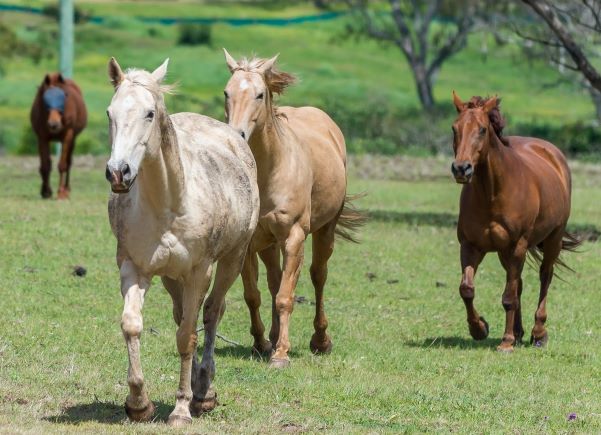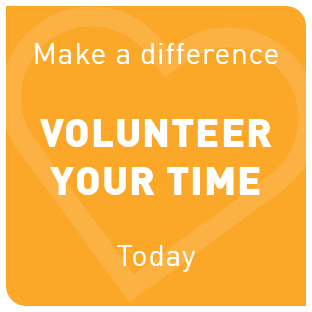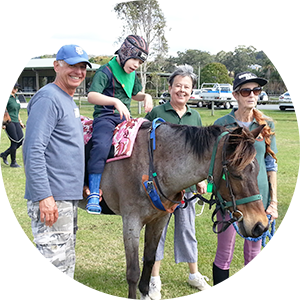Accredited RDA Centres make a huge difference to the lives and futures of children and adults living with special needs and disability.
Who We Help
RDAQ recognises the international definition of ‘disability’ as ‘any condition that restricts a person’s mental, sensory and or mobility functions. It may be caused by accident, trauma, genetics, or disease. A disability may be temporary or permanent, total, or partial, lifelong, or acquired, visible, or invisible.’
People with all types and levels of disability are accepted into RDA programs (including but not limited to):
- Attention Deficit Disorder
- Autism Spectrum Disorder
- Cerebral Palsy
- Down Syndrome
- Epilepsy
- Hearing Impairment
- Multiple Sclerosis
- Muscular Dystrophy
- Spina Bifida
- Vision Impairment
- Anxiety
- Depression
How our programs help
Animals often create a special bond with humans, and this is especially true with horses.
The nonverbal communication between the person and the horse strengthens the emotional bond that is often created. Words aren’t needed for each to be perfectly in tune with each other. Emotions find space to flow and the relationship between the person and the horse can create a love and understanding that is often indescribable.
The Mental Health Foundation highlights that ‘finding an activity you enjoy can give you a goal to aim for and a sense of purpose. It can also be a great way to meet people, have a break from daily life and gain confidence. Other benefits include:
- less tension, stress, and mental fatigue
- a natural energy boost
- a sense of achievement
- more focus and motivation
- feeling less angry or frustrated
- a healthy appetite
- having fun.
It’s even better if you’re able to get active outdoors. Research shows that being in nature can make us feel happier, feel our lives are more worthwhile, and reduce our levels of depression and anxiety’.
PHYSICAL BENEFITS
As the horse moves the rider is constantly thrown off balance, requiring the rider’s muscles to contract and relax to rebalance. This exercising is similar to physiotherapy, reaching the deep muscles, but making the therapy more enjoyable and even fun!
The three-dimensional rhythmic movement of the horse is similar to the motion of walking, teaching rhythmical patterns to the muscles of the legs and trunk. By placing the rider in different positions on the horse (therapeutic riding) different muscles are worked. Stopping and starting the horse as well as changing the speed and direction increases the benefits.
Strengthened Muscles
Muscles are strengthened by the increased use involved in riding. Even though riding is exercise, it is perceived as enjoyment, therefore the rider has increased tolerance and motivation to lengthen the period of exercise.
- Improved Coordination, Faster Reflexes and Better Motor Planning
Riding a horse requires a great deal of coordination to get the desired response from the horse. Since the horse provides instant feedback to every action from the rider, it is easy to know when you have given the correct cue. Repetition of the patterned movements required in controlling a horse quickens the reflexes and aids in motor planning.
- Stretching of Tight or Spastic Muscles
Sitting on a horse requires stretching of the adductor muscles of the thighs. This is accomplished by pre-stretching exercises prior to mounting and by starting the rider on a narrow horse and gradually working to wider horses. Gravity helps stretch the calf muscles when the rider sits on the horse without stirrups. Stomach and back muscles are stretched by encouraging the rider to maintain an upright position against the movement of the horse. Arm and hand muscles are stretched by the act of holding the reins. The rhythmic motion and warmth of the horse aids in relaxation, particularly of the legs. Sitting astride the horse helps break the extensor spasms of lower limbs. Holding the reins helps to break the flexor spasm patterns of upper limbs. Fatigue helps to decrease spasticity by producing relaxation.
- Increased Range of Motion of the Joints
As spasticity is reduced, range of motion increases. Range of motion is also improved by the act of mounting and dismounting, tacking, grooming and exercises during the lesson
- Improved Respiration and Circulation
Although riding is not normally considered a cardiovascular activity, trotting and cantering do increase both respiration and circulation.
- Improved Appetite and Digestion
Like all forms of exercise, riding stimulates the appetite
Riding stimulates the tactile senses through both touch and environmental stimuli. The many sounds of the outdoor setting helps to involve the auditory system.
PSYCHOLOGICAL BENEFITS
Interaction with horses relaxes and de-stresses in equal parts, freeing the mind from day-to-day stress. Many psychologists recommend equine therapy to deal with anxiety and stress.
Spending time with horses or ponies also can help people relate to others. It can improve the self-control of emotions and teaches participants to express what they are feeling in an appropriate way.
Confidence is gained in mastering new skills and developing new abilities that were not previously thought possible.
- Unconditional Love and Acceptance
The love and understanding that a horse can sometimes give can be much more enriching than what some people can offer. This is something that anyone who has spent time with a horse knows.
The RDA programs are designed to improve concentration and attention span. The participant focuses on the relationship with the horse and the task at hand, listening for instructions from the coach and volunteers as they learn to guide the horse around an arena, groom the horse, complete a Trail Ride, or compete in a Dressage Test.
- Identifying and Coping with Feelings
Working with horses or ponies is a powerful way to get in touch with thoughts and feelings. Horses have a unique ability to sense emotions and react accordingly.
If you are angry or aggressive, the horse may become obstinate. If you are anxious, the horse may get skittish. But when approached by someone who is open and calm, the horse is more likely to respond in kind. Witnessing the horse’s response promotes self-awareness and can help people see themselves in a more realistic way.
- Communication & Interpersonal Skills
Many people living with disability may have difficulty relating or getting close to other people. Yet they manage to establish close bonds with horses.
Through working with horses, people can often recognise their patterns of interacting with others. Horses do not speak, but they are excellent communicators. Learning to understand a horse’s behaviour can help people learn that their own behaviour and body language impacts others.
Ground-based exercises as simple as haltering, leading, and grooming teach people how to approach others with respect and awareness.
Lessons may be as simple as how much physical space the horse needs to feel comfortable. Without any words at all, horses make clear when someone has crossed their boundaries. Trying to control or dominate will not work with a horse. Likewise, a detached or passive approach can make it difficult to lead a horse.
Horses are large animals. Their strength and size can bring up unmet needs, fears, past trauma and feelings of inadequacy or lack of control.
Some people may fear that the horse won’t like them. They also fear the horse could hurt them physically or emotionally. Rather than giving in to their usual reaction – to escape or get defensive – people learn to tolerate and process the emotion.
In a safe environment, RDA clients learn to face their fears. They build confidence in their ability to overcome challenges. Many people feel intimidated and nervous at first. Later they discover how quickly they process those feelings and find comfort in their relationship with the horse. Empowered by the experience, people may develop the confidence to address other fears. They then transfer these lessons to day-to-day life.
Horses are soothing, gentle animals. They are straightforward in their interactions without lying or manipulating. They do not judge or blame. Their presence alone can be healing. When people open themselves up to a horse, they grow in their ability to build relationships with others.
- General Sense of Well Being
Exercise in the fresh air of the country away from hospitals, doctors offices, therapy rooms, and home helps to promote a sense of well being.
- Increased Interest in One’s Own Life
The excitement of riding or grooming a horse encourages the rider to speak and communicate about their activities.
Other benefits include:
- learning to accept responsibility
- taking care of oneself and others
- patience
- humility
- a sense of pride
- an appreciation for the simple joys in life.
EDUCATIONAL BENEFITS
Before one can be taught to read, it is necessary to recognise the difference in shapes, sizes and colours. These can be taught on horseback through games and activities. There is less resistance to learning when it is part of a horse-riding lesson.
- Improved Mathematic Abilities
Counting is learned by counting the horse’s footfalls, objects around the arena etc. Because the concepts of maths are taught through games, the resistance to learning can be less.
- Better Sequencing, Patterning and Motor Planning
Something as simple as holding a pencil requires a great deal of motor planning. Knowing which comes first in a sequence of events is an important part of most activities. These and other skills are taught on horse back through the use of obstacle courses, pole bending and many other games and activities. Even grooming a horse requires the groom to follow a sequence of activities.
- Improved Hand/Eye Coordination
Eye and hand coordination is necessary for skills such as writing. These skills are taught in grooming and preparing the horse as well as other activities and exercises.
- Visual Spatial Perception
This includes an awareness of form and space, and an understanding relationships between the forms in our environment. Included in this is directionality (knowing right from left), space-perception (knowing when items are close in shape but different), perception of depth (picking out an object from a background) and visual sequential memory (such as remembering patterns).
The rider learns to differentiate significant from less significant stimuli in the environment. An improvement in this area occurs as the rider learns to attend to their horse and those things that may influence the horse rather than attending to the environment in general.
SOCIAL BENEFITS
- Friendship and sense of belonging
Although riding can be a solitary activity, at RDA Centres lessons are normally performed in small groups often at the same time each session. Participants can develop friendships, share achievements, and build a strong sense of belonging.
The benefits of RDA are not limited to the participants. The Centres have a strong history of building a sense of shared purpose and inclusiveness among carers and volunteers drawn from across all parts of the community.
Contact your nearest Centre for more information about the programs they offer.







